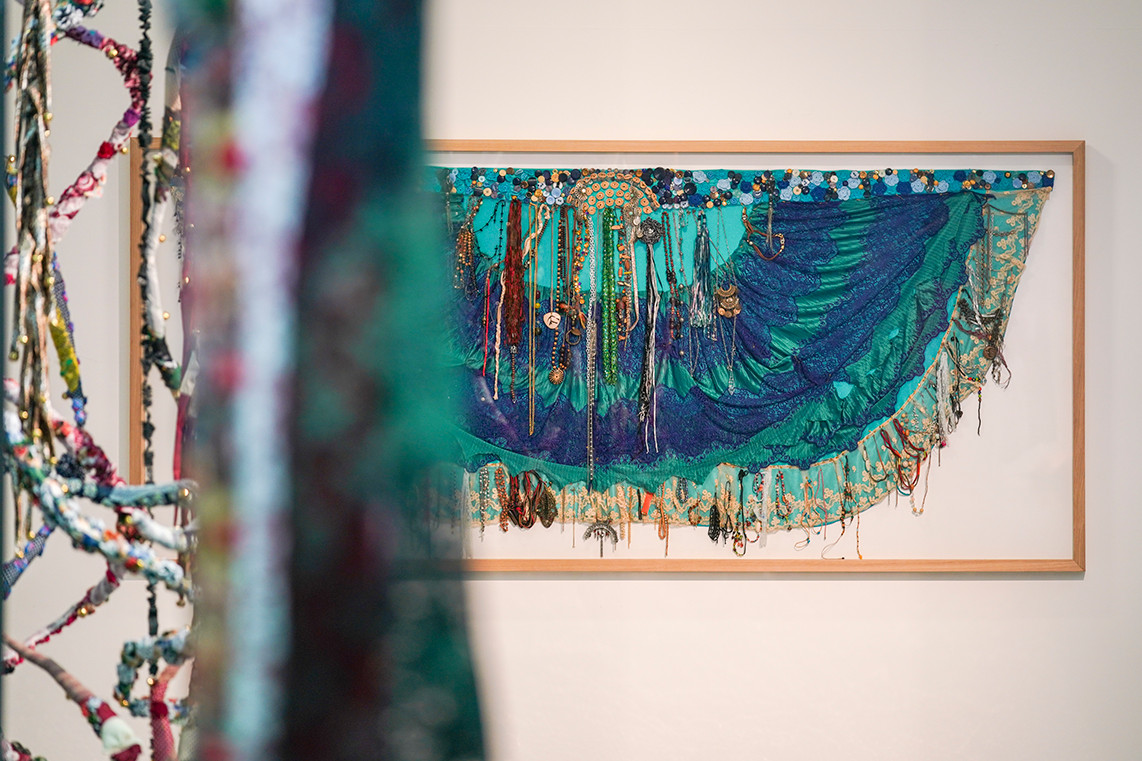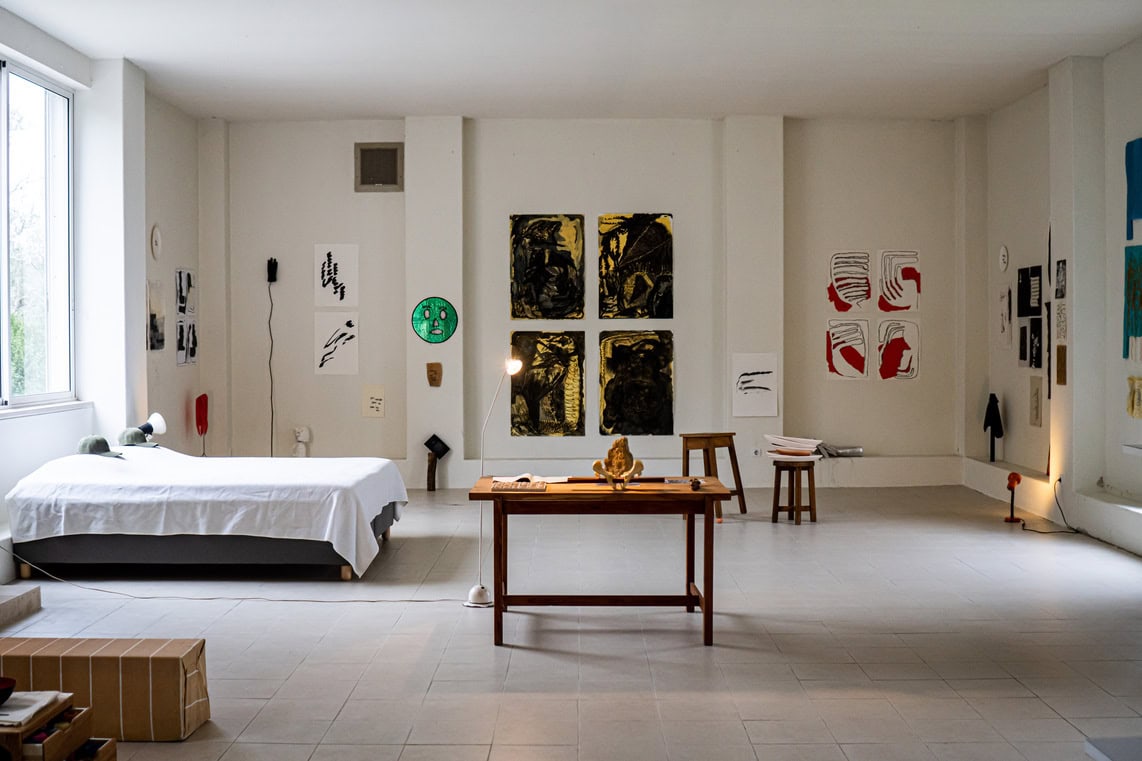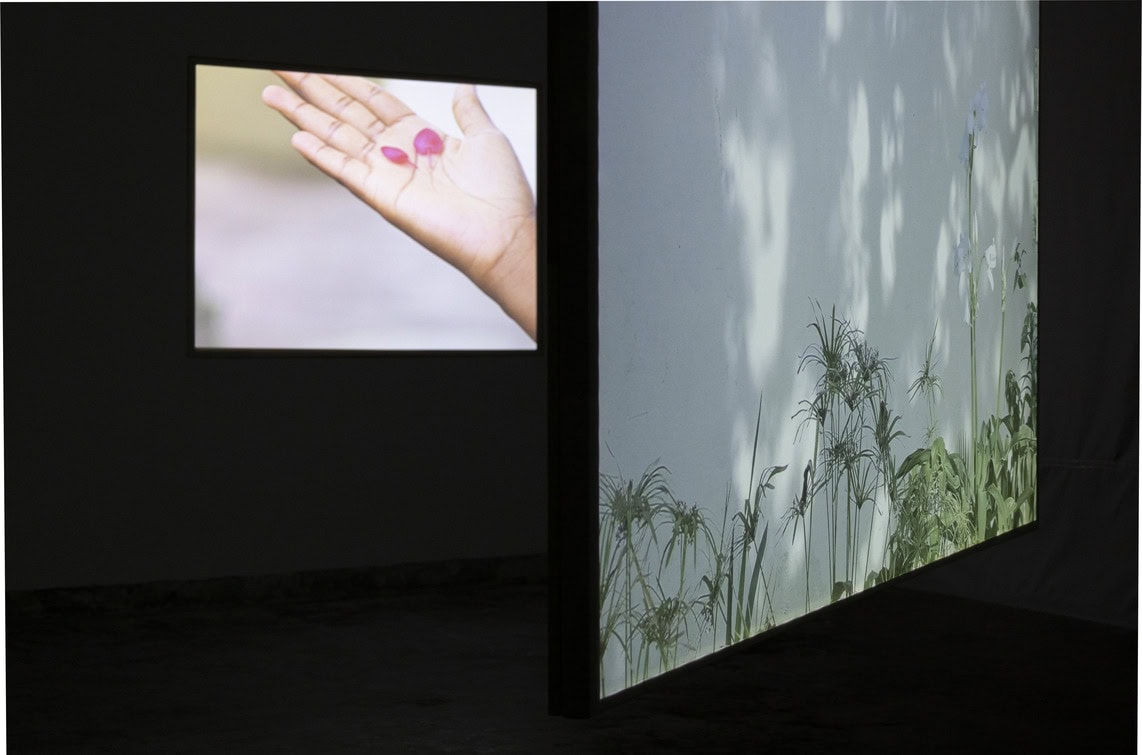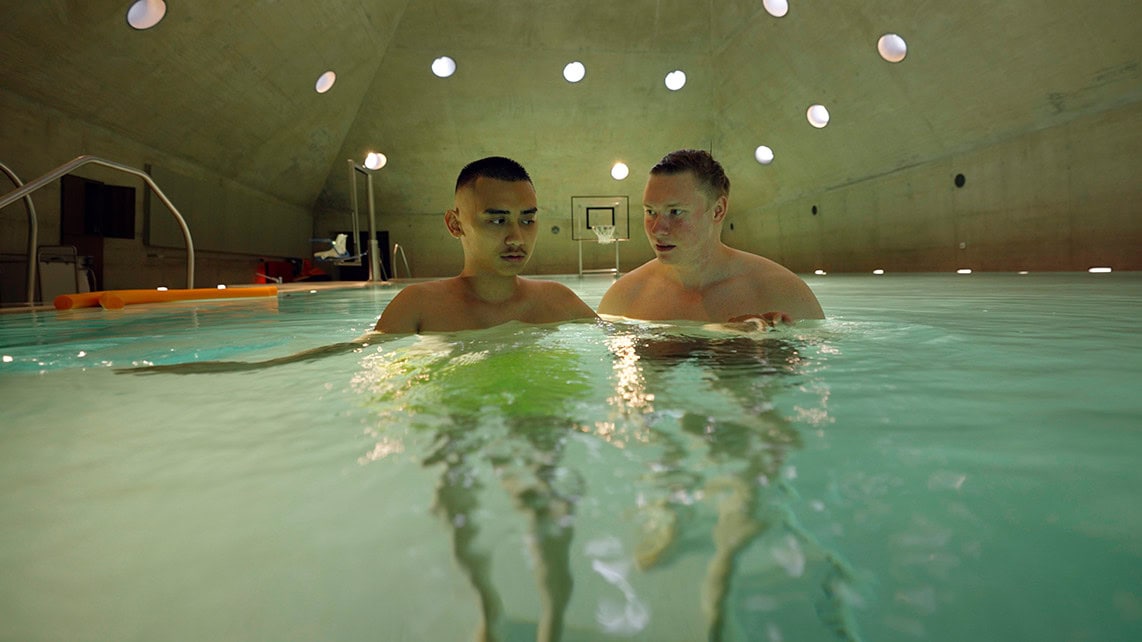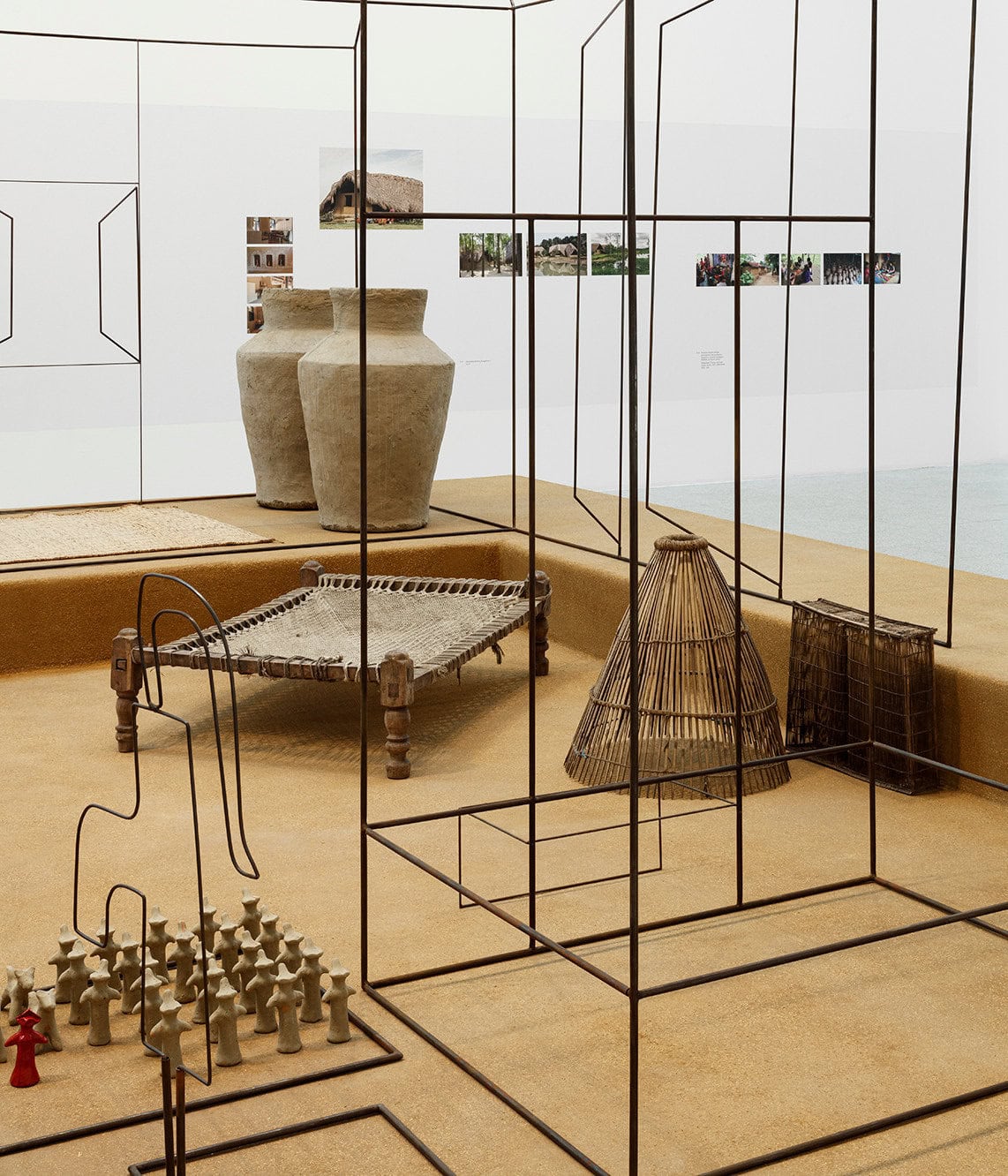We visited Mariana Viegas’ studio-home in Arrábida on a bright winter’s day. The entrance was paved with two rows of trees. The towering cypress trees greeted us. We stepped into the kitchen, where coffee was offered. However, we didn’t drink it there – we were led to the large south-facing balcony overlooking the mountains. We drank it there. We spoke about how that spot was once where Manuel Amado painted and, having also been an architect, converted some of the buildings. Now inhabited by Mariana Viegas, the painter’s niece, together with her family, apart from being the place where they live, it also hosts artists in residence twice a year. There is also an agro-forest and a seed library.
“The idea of moving to this estate came from the notion of breathing life into it. Life being myself, naturally, with my family, but also being all sorts of activities, especially human and not just agricultural, as I’m not a farmer.
We have therefore been welcoming artists and creative projects that essentially involve art and the environment. The aim is to succeed in developing a project that gives artists the chance to come and create in a quiet place, where they are fully immersed in the countryside, but at the same time close to the city, either Setúbal or Lisbon. This means that it is not a completely isolated area.”
The Celeiro Air residency programme is set in the estate’s old barn and had its first two editions last year, with the duo Landra, consisting of Sara Rodrigues and Rodrigo Camacho, and Rui Horta Pereira.
We headed down to Mariana Viegas’ studio. The gate revealed a large framed photograph perched on the ground, in which the natural surroundings surround a group of bathers, many of them attempting to dive into the waters of one of the Wannsee lakes, south-west of Berlin. Standing with her back to the building where Adolf Hitler signed the Final Solution or Final Settlement of the Jewish Question in 1942, i.e., the Nazi genocidal plan for the Jewish population of all German occupied territories during the Second World War, Mariana Viegas was shooting this scene from afar.
“Wannsee is where people from Berlin go to when the weather is good. This is a lovely area where you’ll find a beautiful house museum with an exhibition showing exactly what happened. There Adolf Hitler took it upon himself to sign what the Third Reich called ‘The Final Solution’, whereby Jews were considered a burden to be murdered. This is somehow fascinating, as to how one comes to that conclusion in such an extraordinary place. I certainly took this photograph after being in Berlin for several weeks, months. There’s a grey layer on top. I lived there for almost three years, so I know the atmosphere all too well.”
She explains that many Berliners take the train and go to the beach in Wannsee to soak up the sun and swim. They all stay there, all very white, “very Aryan”. This “human clearing” is not by chance in the centre of the photograph. This idea of humans as part of nature is in keeping with the valorisation of nature that characterised the philosophical movement of German Romanticism, something that Mariana Viegas touches on in some of her pieces. Why Monkeys Do Not Make Good Pets is another example of that. This is an image of the monkey shelter at Tierpark Zoo, in former East Berlin, built with debris from the post-World War II Berlin at the height of communism.
“This was the image I chose and found the most interesting of the many I shot because, in this cage, they opted to do something that was frequently seen in romantic gardens, which is to recreate a ruin, as if we were in the middle of Greece or Italy. German culture is fascinated by the South and the birthplace of Greco-Roman civilisation. The idea of Germania comes from this. And Nazism too, the idea of the perfect man, the Greek statue.”
Columns, capitals, pillars from neoclassical palaces and manor houses, chunks of rubble are reused to build a new ruin. A ruin with a special feature: bullet marks.
“It’s quite interesting to imagine its construction. A construction of the wild. A zoo is a truly miraculous construction, out of time.”
Mariana Viegas’ interest in human construction of the natural or the wild surfaces repeatedly in her work. She photographed, for instance, the US Monument Valley, a protected area commonly visited by tourists, where John Ford’s famous westerns were shot, while also photographing New York’s Central Park, artificially built in an urban context.
“When an area has been set aside to be kept natural, like natural parks in the United States or other countries, this is obviously a construction. In the sense that it is a necessity. We need this contact with nature, we need to preserve it, and we have two options for doing this. The first is by restricting it, by establishing boundaries between this reality and everything else. The second is by building it. Such is the case with parks within cities.”
Creating a relationship between the text, or the word, and the image is another key aspect of her work. We can see some of the images that made up the Ilha exhibition presented in 2010 at Lisbon’s Appleton Square, where this relationship was obvious.
“The photograph has a visible dimension and the text leads us to other images. When we see a photograph, it feels as if we are in that frame, the world is suddenly frozen in that second. Photography is brutal in that sense. Whilst text can take us to other storytelling levels. I believe this is what’s interesting about the connection between text and photography or text and video. In Ilha‘s case, the text extended the photograph. Each photograph included a first sentence that triggered a short story. That text was the possibility of that photograph continuing to exist.”
Moving on, a set of staged photographs reflect the period in which she worked with directors such as Pedro Costa, Raquel Freire, Margarida Gil, Manoel de Oliveira, João César Monteiro and João Botelho, among others.
“Staged photography went hand in hand with some of the press work I was doing at the time. I met João Botelho at Kapa magazine, for which I worked throughout its existence, and I ended up meeting Paulo Branco, with whom João worked, and he told me about doing staged photography.
We needed to take photographs for promoting the film. At the time, we understood that the promotional work would have to be divided between authorial and commercial. I took photos that were exhibited in the cinema – small shots of different scenes from the films – and I took photos of the film’s making off, something more authorial, meaning that I would spend time with the actors and directors, taking portraits. These were black and white and usually done with care and time. I managed to shoot a series of incredible people, such as Werner Schroeter, Isabelle Huppert, Manuel de Oliveira, Michel Piccoli. It was a tremendous learning experience.”
She goes on to mention that Inês Oliveira made a documentary film in her studio specifically about this period in which she worked in the film world. It is now in the editing stage.
“The film is exactly about this period when I worked with all these individuals and shot these images. It’s about how I moved around there. Diplomacy was needed, as the team was under a lot of pressure and I popped up in the midst trying to get my shots.”
We’re captivated by the image of a medallion that reads “não me beijes” (in English “don’t kiss me”). Mariana Viegas explains that it belonged to her father. Back then, this sort of medallion was placed in babies’ cradles or prams to prevent people from kissing them and passing on a virus. This photo is part of a series she took of the objects her father left on his desk following his death, exhibited at Casa A. Molder Gallery in 2023.
“Objects, photos are always tied to this notion of memory. I come from a family of archaeologists, both my parents were archaeologists and my only sister is one too. I’m an archaeologist in the photographic way, which is to say that photography is also a form of archaeology, or maybe it’s not archaeology, but a way of preserving the past or making sure that things happened.
After my father died, he left a desk with all sorts of objects and I decided to photograph them. For me, those objects were him. A series of mundane, everyday belongings that for me took on the status of something treasured or precious. In what way are our existences bound up with objects and what are these things if they are not photographed? It is as if they do not exist, at least for me.”
We finally discuss future projects. We are directed to a table on which numerous small-format photographs are laid out. These are images for a book-monograph that she is working on with the Pierre Von Kleist publishing house, soon to be released. This is a journey through her personal collection, which she managed to finally bring together in one place, the Arrábida estate, following her return to Portugal after living abroad for ten years.
“This is a book where we decided it would be like visiting the archive. Mine starts in ’88, when I was 18. We started looking at contact prints and found out interesting stuff about them today, from an almost sociological viewpoint. What was happening in Lisbon in the late 80s and 90s? There are some extremely interesting images of the city, a Lisbon that no longer exists. That is what photography is all about. Then there is this character, myself, and the people around me. And also all the jobs I had. These were essentially press jobs. For nearly eight years, I mainly worked with Paulo Branco on staged photography. The idea is to build an object that is not exhaustive. This is an emotional journey through this archive right now.”
As for exhibitions, in the wake of the one being held at Escola da Vila in Porto Santo, Porta 33, there will soon be a solo exhibition by Mariana Viegas at Porta 33 in Funchal, curated by Nuno Faria.
“Nuno and I wanted it to be a portrait exhibition. Perhaps draw from this archive some works that could make a connection with the work in Porto Santo, which is a portrait project. Nuno told me that he was planning to use some of Pedro Costa’s photographs that were in the Serralves exhibition Pedro Costa: Companhia. There were also other photographs that I think are quite interesting. There are many self-portraits, which is something I have yet to explore properly, but which I’m keen to do. I haven’t quite worked out what the constellation is going to be yet.”
The sun was starting to set behind the mountains. We left the Arrábida estate sure that we would like to be back.
